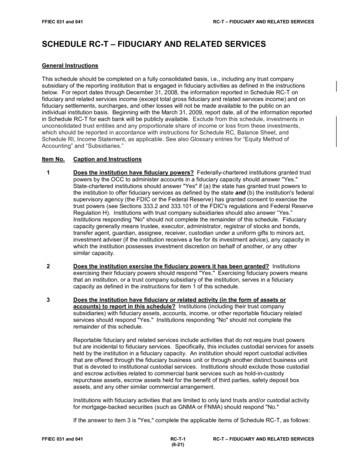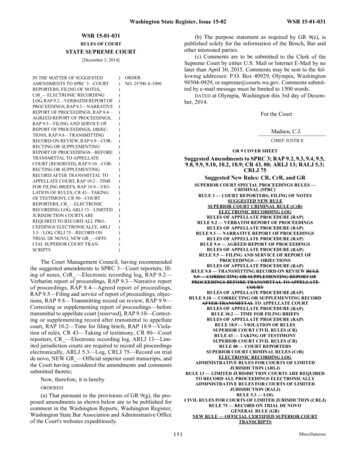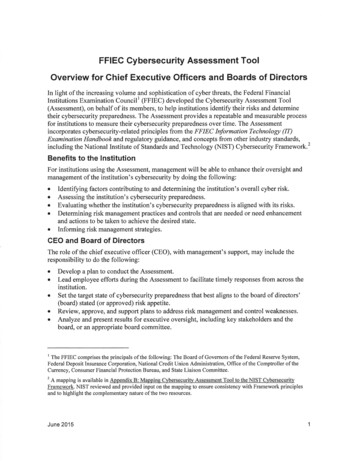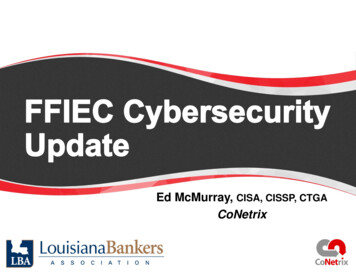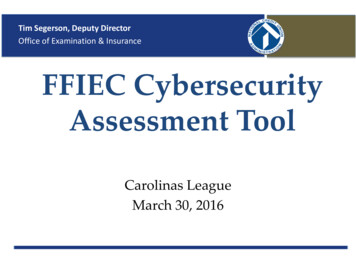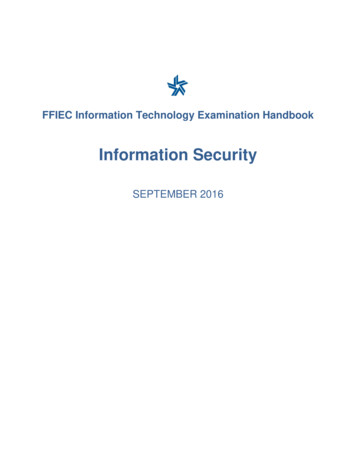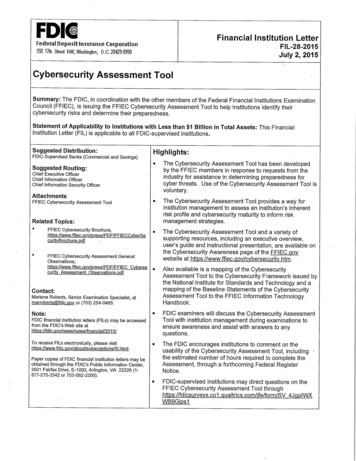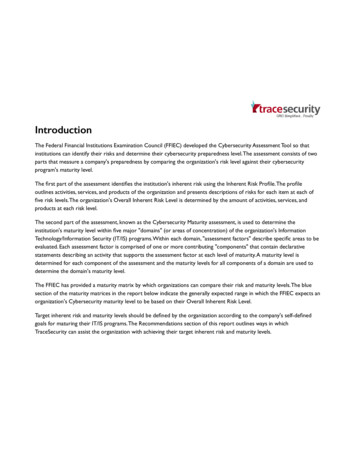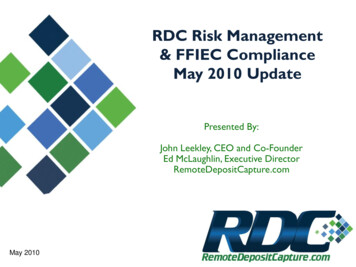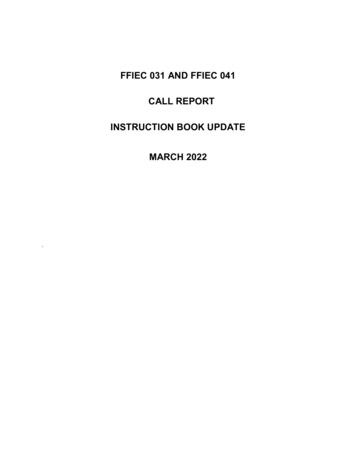
Transcription
FFIEC 031 AND FFIEC 041CALL REPORTINSTRUCTION BOOK UPDATEMARCH 2022.
FILING INSTRUCTIONSNOTE: This update for the instruction book for the FFIEC 031 and FFIEC 041 Call Reports is designedfor two-sided (duplex) printing. The pages listed in the column below headed “Remove Pages” are nolonger needed in the Instructions for Preparation of Consolidated Reports of Condition and Income(FFIEC 031 and FFIEC 041) and should be removed and discarded. The pages listed in the columnheaded “Insert Pages” are included in this instruction book update and should be filed promptly inyour instruction book for the FFIEC 031 and FFIEC 041 Call Reports.Remove PagesInsert PagesCover Page (12-21)7– 8 (3-20)RI-5 – RI-6 (12-20)RC-R-15 – RC-R-16 (12-21)RC-R-29 – RC-R-30 (12-21)RC-R-37 – RC-R-38 (12-21)RC-R-41 – RC-R-42 (12-21)RC-R-63 – RC-R-64 (12-21)RC-R-113 – RC-R-114 (12-21)RC-R-119 – RC-R-120a (12-21)Cover Page (3-22)7– 8 (3-22)RI-5 – RI-6 (3-22)RC-R-15 – RC-R-16 (3-22) *RC-R-29 – RC-R-30 (3-22)*RC-R-37 – RC-R-38 (3-22) *RC-R-41 – RC-R-42 (3-22)RC-R-63 – RC-R-64 (3-22) *RC-R-113 – RC-R-114 (3-22) *RC-R-119 – RC-R-120a (3-22) **Updates to these pages are limited solely to technical and non-substantive edits such as formatting,spacing, indentation, capitalization, and removal of outdated accounting terminology.(3-22)
Instructions for Preparation ofConsolidated Reports of Condition and IncomeFFIEC 031 and FFIEC 041Updated March 2022
This page intentionally left blank.
FFIEC 031 and 041GENERAL INSTRUCTIONSreporting the data items to which the threshold applies in the quarter after the four consecutive quarters inwhich its total assets, agricultural loans, or credit card lines have fallen below the applicable threshold.However, if the institution exceeds the threshold as of a subsequent June 30 report date, the data itemswould again be required to be reported in March of the following year.For example, if June 30, 2019, is the first June 30 as of which an institution reports 10 billion or more intotal assets, the institution must begin reporting the data items to which the 10 billion total assetsthreshold applies as of the March 31, 2020, report date. If the institution reports less than 10 billion intotal assets each quarter-end from September 30, 2019, through June 30, 2020, it may cease reportingthe data items applicable to institutions with 10 billion or more in total assets beginning September 30,2020. In contrast, if instead the institution reports 10 billion or more in total assets as of September 30and December 31, 2019, but then reports less than 10 billion in total assets each quarter-end fromMarch 31, 2020, through December 31, 2020, it may cease reporting the data items applicable toinstitutions with 10 billion or more in total assets beginning March 31, 2021.Other shifts in reporting status occur when:(1) A bank with domestic offices only establishes or acquires any "foreign" office. The bank must beginfiling the FFIEC 031 report form (Consolidated Reports of Condition and Income for a Bank withDomestic and Foreign Offices) for the first quarterly report date following the commencement ofoperations by the "foreign" office. However, a bank with "foreign" offices that divests itself of all its"foreign" offices must continue filing the FFIEC 031 report form through the end of the calendar yearin which the cessation of all operations of its "foreign" offices was completed.(2) An institution is involved in a business combination, a transaction between entities under commoncontrol, or a branch acquisition that is not a business combination. Beginning with the first quarterlyreport date following the effective date of such a transaction involving an institution and one or moreother depository institutions, the resulting institution, regardless of its size prior to the transaction,must (a) file the FFIEC 031 report form if it acquires any "foreign" office or has total consolidatedassets of 100 billion or more, and (b) report the additional required information described above onthe FFIEC 031 report form or the FFIEC 041 report form, as applicable, if, after the consummation ofthe transaction, its consolidated total assets surpass the total asset thresholds or it exceeds theagricultural loan percentage or the credit card lines threshold.(3) An institution that files the FFIEC 051 report form becomes an advanced approaches institution forregulatory capital purposes or a large or highly complex institution for deposit insurance assessmentpurposes. The institution must begin filing the FFIEC 031 report form for the first quarterly report dateafter the date it becomes such an institution.(4) An institution that files the FFIEC 051 report form becomes a Category III institution for regulatorycapital purposes. The institution must begin filing the FFIEC 041 report form for the first quarterlyreport date after the date it becomes such an institution (unless it establishes or acquires a “foreignoffice” in the same quarter that it becomes such an institution, in which case the institution must beginfiling the FFIEC 031 report form for that first quarterly report date).In addition, beginning with the first quarterly report date after an operating depository institution that wasnot previously a member of the Federal Deposit Insurance Corporation (FDIC) becomes an FDIC-insuredinstitution, it must file (a) the FFIEC 031 report form if it has any "foreign" office or has total consolidatedassets of 100 billion or more at the time it becomes FDIC-insured, (b) the FFIEC 041 report form if it hastotal consolidated assets of less than 100 billion at the time it becomes FDIC-insured, including theadditional required information described above on the FFIEC 041 report form based on its total assetsand agricultural loans at the time it becomes FDIC-insured, or (c) the FFIEC 051 report form if it is eligibleto, and chooses to, file this report form, including certain additional required information based on its totalassets and agricultural loans at the time it becomes FDIC-insured.FFIEC 031 and 0417(3-22)GENERAL INSTRUCTIONS
FFIEC 031 and 041GENERAL INSTRUCTIONSORGANIZATION OF THE INSTRUCTION BOOKThis instruction book covers both the FFIEC 031 and FFIEC 041 report forms.1 It is divided into thefollowing sections:(1) The General Instructions describe overall reporting requirements.(2) The Line Item Instructions for each schedule of the Consolidated Report of Income.(3) The Line Item Instructions for each schedule of the Consolidated Report of Condition.The instructions and definitions in sections (2) and (3) are not necessarily self-contained; reference tomore detailed treatments in the Glossary may be needed.(4) The Glossary presents, in alphabetical order, definitions and discussions of accounting and reportingissues and other topics that require more extensive treatment than is practical to include in the lineitem instructions or that are relevant to several line items or to the overall preparation of thesereports. The Glossary is not, and is not intended to be, a comprehensive discussion of the principlesof bank accounting or reporting.In determining the required treatment of particular transactions or portfolio items or in determining thedefinitions and scope of the various items, the General Instructions, the line item instructions, and theGlossary (all of which are extensively cross-referenced) must be used jointly. A single section does notnecessarily give the complete instructions for completing all the items of the reports.The instruction book for the FFIEC 031 and FFIEC 041 report forms is available on the Internet on theFFIEC’s website (http://www.ffiec.gov/ffiec report forms.htm) and on the FDIC’s /call/call.html).PREPARATION OF THE REPORTSBanks are required to prepare and file the Call Report in accordance with these instructions. All reportsshall be prepared in a consistent manner.The bank's financial records shall be maintained in such a manner and scope so as to ensure that theCall Report can be prepared and filed in accordance with these instructions and reflect a fair presentationof the bank's financial condition and results of operations.Questions and requests for interpretations of matters appearing in any part of these instructions shouldbe addressed to the bank's primary federal bank supervisory agency (i.e., the Federal Reserve Banks,the OCC, or the FDIC). Such inquiries will be referred for resolution to the Task Force on Reports of theFederal Financial Institutions Examination Council (FFIEC). Regardless of whether a bank requests aninterpretation of a matter appearing in these instructions, when a bank's primary federal bank supervisoryagency's interpretation of the instructions differs from the bank's interpretation, the supervisory agencymay require the bank to prepare its Call Report in accordance with the agency's interpretation and toamend previously submitted reports.1A separate instruction book covers the FFIEC 051 report form.FFIEC 031 and 0418(3-22)GENERAL INSTRUCTIONS
FFIEC 031 and 041RI - INCOME STATEMENTFFIEC 041 FFIEC 031Item No. Item No. Caption and Instructions1.a.(5)1.a.(1)(f)Interest and fee income on all other loans. On the FFIEC 041, report interest,fees, and similar charges levied against or associated with loans reportable inSchedule RC-C, Part I, item 2, “Loans to depository institutions and acceptancesof other banks,” item 3, “Loans to finance agricultural production and other loansto farmers,” item 8, “Obligations (other than securities and leases) of states andpolitical subdivisions in the U.S.,” and item 9, “Loans to nondepository financialinstitutions and other loans.”On the FFIEC 031, report interest, fees, and similar charges levied against orassociated with loans in domestic offices reportable in Schedule RC-C, Part I,item 2, “Loans to depository institutions and acceptances of other banks,” item 8,“Obligations (other than securities and leases) of states and political subdivisionsin the U.S.,” and item 9, “Loans to nondepository financial institutions and otherloans.”-1.a.(6)1.a.(2)Interest and fee income on loans in foreign offices, Edge and Agreementsubsidiaries, and IBFs. Report all interest, fees, and similar charges leviedagainst or associated with all loans in foreign offices, Edge and Agreementsubsidiaries, and IBFs reportable in Schedule RC-C, Part I, items 1 through 9.1.a.(3)Total interest and fee income on loans. On the FFIEC 041, report the sum ofitems 1.a.(1) through 1.a.(5) in item 1.a.(6). On the FFIEC 031, report the sum ofitems 1.a.(1)(a) through 1.a.(2) in item 1.a.(3).FFIEC 031 and 041Item No. Caption and Instructions1.bIncome from lease financing receivables. Report all income from leases reportable inSchedule RC-C, Part I, item 10, "Lease financing receivables (net of unearned income)."(See the Glossary entry for "lease accounting.")Include income from:(1) Direct financing leases accounted for under ASC Topic 840, Leases, by an institution thathas not adopted ASC Topic 842, Leases;(2) Direct financing and sales-type leases accounted for under ASC Topic 842 by aninstitution that has adopted ASC Topic 842; and(3) Leveraged leases accounted for under ASC Topic 840 (including leveraged leases thatwere grandfathered upon the adoption of ASC Topic 842 and remain grandfathered).Exclude from income from lease financing receivables:(1) Any investment tax credits associated with leased property (include in Schedule RI,item 9, "Applicable income taxes (on item 8.c)").(2) Provisions for losses on leases (report in Schedule RI, item 4, "Provision for loan andlease losses").(3) Rental fees applicable to operating leases for furniture and equipment rented to others(report as "Other noninterest income" in Schedule RI, item 5.l).1.cInterest income on balances due from depository institutions. Report all income onassets reportable in Schedule RC, item 1.b, “Interest-bearing balances due from depositoryinstitutions,” including interest-bearing balances maintained to satisfy reserve balancerequirements, excess balances, and term deposits due from Federal Reserve Banks. Includeinterest income earned on interest-bearing balances due from depository institutions that arereported at fair value under a fair value option.FFIEC 031 and 041RI-5(3-22)RI - INCOME STATEMENT
FFIEC 031 and 041Item No.1.dRI - INCOME STATEMENTCaption and InstructionsInterest and dividend income on securities. Report in the appropriate subitem all incomeon debt securities that are reportable in Schedule RC-B, Securities. Include accretion ofdiscount and deduct amortization of premium on debt securities. Refer to the Glossary entryfor "premiums and discounts." Include in the appropriate subitem prepayment penaltiesreceived on debt securities.Also include dividend income on equity securities with readily determinable fair values notheld for trading that are reportable in Schedule RC, item 2.c.Include interest on debt securities held in the bank's held-to-maturity and available-for-saleportfolios and dividends on equity securities with readily determinable fair values not held fortrading, even if such securities have been lent, sold under agreements to repurchase that aretreated as borrowings, or pledged as collateral for any purpose.Include interest received at the sale of debt securities to the extent that such interest had notalready been accrued on the bank's books.Do not deduct accrued interest included in the purchase price of debt securities from incomeon securities and do not charge to expense. Record such interest in a separate assetaccount (to be reported in Schedule RC, item 11, "Other assets") to be offset upon collectionof the next interest payment.Report income from detached U.S. Government security coupons and ex-couponU.S. Government securities not held for trading in Schedule RI, item 1.d.(3), as interest anddividend income on "All other securities." Refer to the Glossary entry for "coupon stripping,Treasury receipts, and STRIPS."Exclude from interest and dividend income on securities:(1) Realized gains (losses) on held-to-maturity securities and on available-for-sale debtsecurities (report in Schedule RI, items 6.a and 6.b, respectively).(2) Net unrealized holding gains (losses) on available-for-sale debt securities (include theamount of such net unrealized holding gains (losses) in Schedule RC, item 26.b,“Accumulated other comprehensive income,” and the calendar year-to-date change insuch net unrealized holding gains (losses) in Schedule RI-A, item 10, “Othercomprehensive income”).(3) The year-to-date change in net unrealized gains (losses), and any realized gains(losses), on equity securities with readily determinable fair values not held for trading(report in Schedule RI, item 8.b).(4) Income from advances to, or obligations of, majority-owned subsidiaries not consolidated,associated companies, and those corporate joint ventures over which the bank exercisessignificant influence (report as "Noninterest income" in the appropriate subitem ofSchedule RI, item 5).1.d.(1)Interest and dividend income on U.S. Treasury securities and U.S. Government agencyobligations (excluding mortgage-backed securities). Report income from all securitiesreportable in Schedule RC-B, item 1, “U.S. Treasury securities,” and item 2,“U.S. Government agency obligations.” Include accretion of discount on U.S. Treasury bills.FFIEC 031 and 041RI-6(3-22)RI - INCOME STATEMENT
FFIEC 031 and 041RC-R – REGULATORY CAPITALPart I. (cont.)Item No.Caption and Instructions10.b(cont.)An advanced approaches institution that has exited parallel run, has adopted ASU2016-13, and has elected to apply the 5-year 2020 CECL transition provision (5-yearCECL electing advanced approaches institution) should decrease its eligible creditreserves by the applicable eligible credit reserves transitional amount in accordance withsection 301 of the regulatory capital rules. Specifically, a 5-year CECL electing advancedapproaches institution should reduce the amount of its eligible credit reserves by 100percent of its eligible credit reserves transitional amount during the first and second yearsof the transition period, 75 percent of its eligible credit reserves transitional amount duringthe third year of the transition period, 50 percent of its eligible credit reserves transitionalamount during the fourth year of the transition period, and 25 percent of its eligible creditreserves transitional amount during the fifth year of the transition period (see Example ofApplication of the 5-Year 2020 CECL Transition Provision for Third Quarter 2020 in theGeneral Instructions for Schedule RC-R, Part I).(7) Deductions for non-includable subsidiaries. A savings association that has a nonincludable subsidiary must deduct its outstanding investments (both equity and debt) in,and extensions of credit to, the subsidiary in this item 10.b.11LESS: Non-significant investments in the capital of unconsolidated financialinstitutions in the form of common stock that exceed the 10 percent threshold fornon-significant investments.(i) All non-advanced approaches institutions (column A on the FFIEC 031):Not applicable. Proceed to Schedule RC-R, Part I, item 12, (column A on the FFIEC 031,)to complete the subtotal calculation.(ii) All advanced approaches institutions (column B on the FFIEC 031):An institution has a non-significant investment in the capital of an unconsolidated financialinstitution if it owns 10 percent or less of the issued and outstanding common shares of thatinstitution.Report the amount of non-significant investments in the capital of unconsolidated financialinstitutions in the form of common stock that, in the aggregate with covered debt instruments,as applicable,1 exceed the 10 percent threshold for non-significant investments, calculated asdescribed below.2 The institution may apply associated DTLs to this deduction.Covered debt instrument is defined in 12 CFR 3.2, 12 CFR 217.2, and 12 CFR 324.2, as applicable.An institution may exclude covered debt instruments (as defined in 12 CFR 3.2, 12 CFR 217.2, and 12 CFR 324.2,as applicable) from the calculation of non-significant investments in the capital and covered debt instruments ofunconsolidated financial institutions. An institution subject to the advanced approaches rule that is not a subsidiary ofa global systemically important banking organization, as defined in 12 CFR 252.2, may exclude covered debtinstruments up to an amount of 5 percent of the amount reported in Schedule RC-R, Part I, item 12, column B.12FFIEC 031 and 041RC-R-15(3-22)RC-R – REGULATORY CAPITAL
FFIEC 031 and 041RC-R – REGULATORY CAPITALPart I. (cont.)Item No.Caption and Instructions11(cont.)Example and a worksheet calculation for all advanced approaches institutions:Assumptions: Assume that an institution has a total of 200 in non-significant investments in thecapital of unconsolidated financial institutions, of which 100 is in common shares.For this example, all of the 100 in common shares is in the common stock of apublicly traded financial institution. Assume the amount reported in Schedule RC-R, Part I, item 5, “Common equity tier 1capital before adjustments and deductions,” is 1,000. Assume the amounts reported in Schedule RC-R, Part I, items 6 through 9.f, areall 0.(1)(2)(3)(4)(5)Determine the aggregate amount of non-significantinvestments in the capital of unconsolidated financialinstitutions (including in the form of common stock, additionaltier 1 capital, tier 2 capital, and covered debt instruments, asapplicable).Determine the amount of non-significant investments in thecapital of unconsolidated financial institutions in the form ofcommon stock.Subtract from Schedule RC-R, Part I, item 5, the amounts inSchedule RC-R, Part I, items 6, 7, 8, 9, 10.a, and 10.b.Multiply the amount in step (3) by 10 percent. This is “the tenpercent threshold for non-significant investments.”If (1) is greater than (4), subtract (4) from (1) and multiply theresult by the ratio of (2) divided by (1). Report this amount inthis Schedule RC-R, Part I, item 11.If (1) is less than (4), enter zero in this item 11.(6)Assign the applicable risk weight to the amount of nonsignificant investments in the capital of unconsolidatedfinancial institutions that does not exceed the ten percentthreshold for non-significant investments. 200 100 1,000 - 0 1,000 1,000 x 10% 100Line (1) is greater thanline (4); therefore, 200 100 100. Then( 100 x 100/200) 50.Report 50 in this item11.Of the 100 in commonshares, 50 are deductedin this item 11. Theremaining 50 needs tobe included in riskweighted assets inSchedule RC-R, Part II. ** In this case (assuming that publicly traded equity exposures do not qualify for a 100 percent riskweight under section 52(b)(3)(iii) of the regulatory capital rules), 50 x 300 percent risk weight forpublicly traded common shares under section 52(b)(5) of the capital rules 150 in risk-weightedassets for the portion of common shares in an unconsolidated financial institution that are notdeducted.FFIEC 031 and 041RC-R-16(3-22)RC-R – REGULATORY CAPITAL
FFIEC 031 and 041RC-R – REGULATORY CAPITALPart I. (cont.)FFIEC 041 FFIEC 031Item No. Item No. Caption and Instructions-16(cont.)(5)(6)(7)FFIEC 031 and 041The 15 percent common equity tier 1 capital deductionthresholdCalculate as follows:a. Subtract the amount calculated in step (1.d) of thistable from Schedule RC-R, Part I, item 12, column B;b. Multiply the resulting amount by 17.65 percentAmount of threshold items that exceed the 15 percentcommon equity tier 1 capital deduction thresholdReport as follows:a. If the amount in step (4.d) is greater than the amount instep (5), then subtract (5) from (4.d) and report thisnumber in Schedule RC-R, Part I, item 16. (In addition,the institution must risk-weight the items that are notdeducted at 250 percent in the risk-weighted assetsection of this form.)b. If the amount in step (4.d) is less than the amount instep (5) amount, report zero in Schedule RC-R, Part I,item 16.If the amount in step (6) is above zero, then pro-rate thethreshold items’ deductions as follows:a. Significant investments in the capital of unconsolidatedfinancial institutions in the form of common stock:multiply (6.a) by the ratio of (1.a) over (1.d).b. MSAs net of associated DTAs: multiply (6.a) by theratio of (1.b) over (1.d).c. DTAs arising from temporary differences that could notbe realized through net operating loss carrybacks:multiply (6.a) by the ratio of (1.c) over (1.d).RC-R-29(3-22)( 130 - 60) x17.65% 12.36Rounds to 12The amount in step(4.d) ( 36) isgreater than theamount in step 3( 12).Therefore: 36 - 12 24a. 12 x (10/60) 2b. 12 x (20/60) 4c. 12 x (30/60) 6.RC-R – REGULATORY CAPITAL
FFIEC 031 and 041RC-R – REGULATORY CAPITALPart I. (cont.)FFIEC 041 andFFIEC 031Item No. Caption and Instructions17LESS: Deductions applied to common equity tier 1 capital due to insufficient amountsof additional tier 1 capital and tier 2 capital to cover deductions.(i) All non-advanced approaches institutions (column A on the FFIEC 031):Report the total amount of deductions related to investments in own additional tier 1 andtier 2 capital instruments, reciprocal cross-holdings, and investments in the capital ofunconsolidated financial institutions if the reporting institution does not have a sufficientamount of additional tier 1 capital before deductions (reported in Schedule RC-R, Part I,item 23) and tier 2 capital before deductions (reported in Schedule RC-R, Part I, item 44 onthe FFIEC 041; item 44.a on the FFIEC 031) to absorb these deductions in Schedule RC-R,Part I, items 24 or 45, as appropriate.Since the community bank leverage ratio (CBLR) framework does not have a total capitalrequirement, a CBLR electing institution is neither required to calculate tier 2 capital nor makeany deductions that would have been taken from tier 2 capital under the generally applicablecapital rule. Therefore, if a CBLR electing institution has investments in the capitalinstruments of an unconsolidated financial institution that would qualify as tier 2 capital of theCBLR electing institution under the generally applicable capital rule (tier 2 qualifyinginvestments), and the institution’s total investments in the capital of unconsolidated financialinstitutions exceed the threshold for deduction, the institution is not required to deduct thetier 2 qualifying investments.(ii) All advanced approaches institutions (column B on the FFIEC 031):Report the total amount of deductions related to investments in own additional tier 1 and tier2 capital instruments; investments in own covered debt instruments, as applicable; reciprocalcross-holdings; non-significant investments in the capital and covered debt instruments, asapplicable, of unconsolidated financial institutions; investments in nonqualifying excludedcovered debt instruments, as applicable;1 and non-common stock significant investments inthe capital and covered debt instruments of unconsolidated financial institutions if thereporting institution does not have a sufficient amount of additional tier 1 capital beforedeductions (reported in Schedule RC-R, Part I, item 23) and tier 2 capital before deductions(reported in Schedule RC-R, Part I, items 44.a and 44.b) to absorb these deductions inSchedule RC- R, Part I, items 24 or 45, as appropriate.18Total adjustments and deductions for common equity tier 1 capital. Report the sum ofSchedule RC-R, Part I, items 13 through 17.19Common equity tier 1 capital. Report Schedule RC-R, Part I, item 12 less item 18. Exceptfor a CBLR electing institution under the community bank leverage ratio framework, theamount reported in this item is the numerator of the institution’s common equity tier 1 riskbased capital ratio.1 Excludedcovered debt instrument is defined in 12 CFR 3.2, 12 CFR 217.2, and 12 CFR 324.2, as applicable.FFIEC 031 and 041RC-R-30(3-22)RC-R – REGULATORY CAPITAL
FFIEC 031 and 041RC-R – REGULATORY CAPITALPart I. (cont.)Item No.Caption and Instructions24(cont.)Since the community bank leverage ratio framework does not have a total capitalrequirement, a CBLR electing institution is neither required to calculate tier 2 capital normake any deductions that would have been taken from tier 2 capital under the generallyapplicable rule. Therefore, if a CBLR electing institution has investments in the capitalinstruments of an unconsolidated financial institution that would qualify as tier 2 capital ofthe CBLR electing institution under the generally applicable rule (tier 2 qualifyinginvestments), and the institution’s total investments in the capital of unconsolidatedfinancial institutions exceed the threshold for deduction, the institution is not required todeduct the tier 2 qualifying investments.(4) Other adjustments and deductions. Include adjustments and deductions applied toadditional tier 1 capital due to insufficient tier 2 capital to cover deductions (related toreciprocal cross-holdings, and investments in the tier 2 capital of unconsolidated financialinstitutions,).Eligible institutions that opt into the community bank leverage ratio framework are notrequired to calculate tier 2 capital and would not be required to make any deductions thatwould be taken from tier 2 capital.In addition, insured state banks with real estate subsidiaries whose continued operationshave been approved by the FDIC pursuant to Section 362.4 of the FDIC's Rules andRegulations generally should include as a deduction from additional tier 1 capital theirequity investment in the subsidiary. (Insured state banks with FDIC-approved phase-outplans for real estate subsidiaries need not make these deductions.) Insured state bankswith other subsidiaries (that are not financial subsidiaries) whose continued operationshave been approved by the FDIC pursuant to Section 362.4 should include as adeduction from additional tier 1 capital the amount required by the approval order.(ii) Advanced approaches institutions:(1) Investments in own additional tier 1 capital instruments. Report the institution’sinvestments in (including any contractual obligation to purchase) its own additional tier 1capital instruments, whether held directly or indirectly.An institution may deduct gross long positions net of short positions in the sameunderlying instrument only if the short positions involve no counterparty risk.The institution must look through any holdings of index securities to deduct investmentsin its own capital instruments. In addition:(i) Gross long positions in investments in an institution’s own regulatory capitalinstruments resulting from holdings of index securities may be netted against shortpositions in the same index;(ii) Short positions in index securities that are hedging long cash or synthetic positionscan be decomposed to recognize the hedge; andFFIEC 031 and 041RC-R-37(3-22)RC-R – REGULATORY CAPITAL
FFIEC 031 and 041RC-R – REGULATORY CAPITALPart I. (cont.)Item No.Caption and Instructions24(cont.)(iii) The portion of the index that is composed of the same underlying exposure that isbeing hedged may be used to offset the long position if both the exposure beinghedged and the short position in the index are covered positions under the marketrisk capital rule, and the hedge is deemed effective by the institution’s internal controlprocesses.(2) Reciprocal cross-holdings in the capital of financial institutions. Include investmentsin the additional tier 1 capital instruments of other financial institutions that the institutionholds reciprocally, where such reciprocal cross-holdings result from a formal or informalarrangement to swap, exchange, or otherwise intend to hold each other’s capitalinstruments. If the institution does not have a sufficient amount of a specific componentof capital to effect the required deduction,
(See the Glossary entry for "lease accounting.") Include income from: (1) Direct financing leases accounted for under ASC Topic 840, Leases, by an institution that . Leveraged leases accounted for under ASC Topic 840 (including leveraged leases that were grandfathered upon the adoption of ASC Topic 842 and remain grandfathered).
